

You can also try turning the Wi-Fi off and on again in the settings of your device, just to be thorough. Try this: Turn off the offending device and turn it back on. “My phone/laptop/tablet won’t connect even though my other devices are fine.”

Take a look at the default network name (usually printed somewhere on the router itself) and see if you recognize that network when looking for a connection. If you feel that your router is positioned in a good location and that overheating isn’t the problem, there are a few other things that could be happening.įor one, your network may have reset itself due to an update. If you’re able to move your router to a place with more airflow, you should be able to solve the overheating issue. If it’s somewhere cramped, such as behind a couch or crammed into a storage closet, it might’ve overheated and shut down automatically to prevent any damage. Try this: Check to see where your router is positioned. “My Wi-Fi network disappeared completely.” You could have an unpaid balance that has caused the company to suspend your account, or there might simply be an outage in your area. If you’ve been through this process and still can’t get connected, you’ll likely need to contact your ISP for help. Doing this will restore the device to factory settings and you’ll be able to go through the first-time setup once again. Most routers have a small “reset” button that needs to be held down with a paperclip or other small object. If restarting the router didn’t fix the issue, you may need to set it up again completely. If you’re able to load web pages through a hardwired connection, there’s definitely something wrong with your Wi-Fi network.

If you can’t, your access has been cut and you should contact your ISP. Try this: Plug an ethernet cable into your router and see if you’re able to get a signal on a desktop or laptop. These tend to be less congested and therefore better performing than their 2.4 GHz counterparts. For starters, you’ll want to use the 5 GHz band whenever possible, if your router supports it. If you think this may be the case, you can try changing the channel your router is broadcasting on. If that’s not an option, it may be worth exploring how to extend your Wi-Fi connection to all areas of your home.Īlso, you might be encountering interference from networks adjacent to yours. First, try moving your router to a more central location in your home. Wired connections will usually always be faster than wireless in some capacity, but the difference shouldn’t be so vast that your Wi-Fi is unusable. If the hardwired connection is much faster than the wireless one, however, there may be more you can do to optimize your network. If they’re both slow, the issue is likely with your service provider and not your equipment. Next, test your speeds on the Wi-Fi connection. Try this: Plug an ethernet cable directly into your router and test your internet speeds using our speed test tool. In order to identify the technique most likely to actually help you, let’s break down some common issues: “I’m experiencing slower-than-normal network speeds.” If you’ve tried the quick fix above to no success, there are still several other ways you may be able to troubleshoot your Wi-Fi connection. How to Troubleshoot Wi-Fi The appearance of routers differs from brand to brand, but the core functionality is the same: directing digital traffic over Wi-Fi.
Suddenlink how to connect to wps wifi manual#
Pro tip: You can usually find a digital copy of your router’s manual by typing your device model number followed by “user manual” into Google. Important note: In order to be clear on what your specific device is communicating to you, refer to the user manual for a more detailed explanation. This signals that a device is plugged in and functioning normally.Īn orange or amber light may indicate a problem or limited connectivity.Ī red or unlit icon may signal that there is no current connection. When everything is working properly, the icons are a solid or blinking green or blue light. Interpreting the Colors of Your Router’s Lights This icon can also look like an empty square or a box with a line striking through, depending on the ethernet connection you’re using. The ethernet icon will light without blinking when ethernet cables are connected and working properly. Wi-Fi icon: solid when Wi-Fi is being broadcast with no issues. Globe icon: solid when modem is connected to the internet. Though these can vary from brand to brand, most manufacturer’s include at least three primary status indicators:
Suddenlink how to connect to wps wifi series#
Most routers have a series of icons that illuminate to convey different status messages at a glance.


 0 kommentar(er)
0 kommentar(er)
